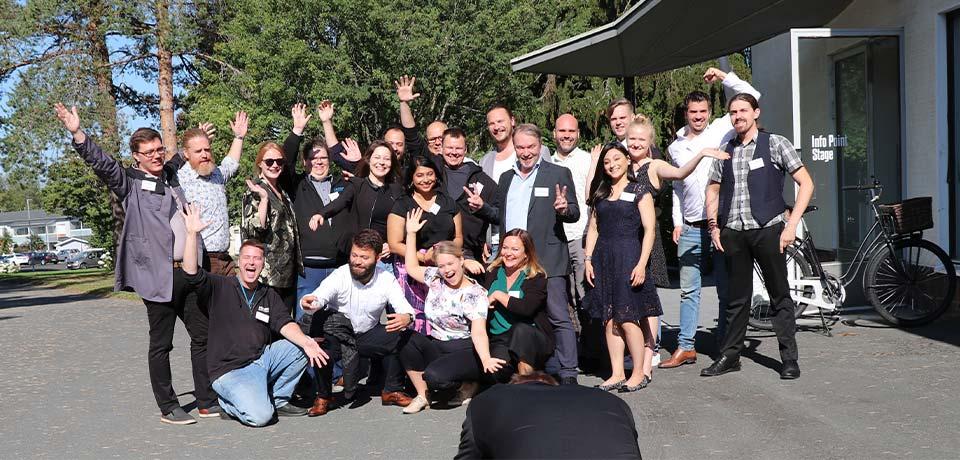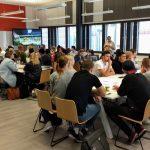
Kristiina Kiiski, Jukka Raitanen & Jari Jussila
This article depicts how HAMK Design Factory approaches its organizational culture, what the different stakeholders inside the higher education institution that affect the manifestation and outcomes of the culture are and how the external networks influence the co-creation of the identity of HAMK Design Factory.
The driving force of the article is to understand which factors and possible restrictions should be taken into consideration when forming a new organizational culture. The article approaches the perspective also from the construct of the organization as the limitations might relate to the whole organization and not just one organizational unit.
Learning from other Design Factories
Today there are 40 Design Factories in 24 countries on five continents. The Finnish Aalto Design Factory (ADF) has been the longest in operation and has also studied the Design Factory culture. In 2011, the Design Factory Research team wrote an article based on their research among the ADF staff members about the ADF culture. At the time of the research project, ADF had been running for three years. The research was based on in-depth interviews with 51 ADF community members and was supplemented by 177 further interviews. In addition, the research team observed the ADF Kafis for a week, the café-office-kitchen in the ADF building. (Björklund et al., 2011)
The study showed that the members of the ADF community felt like one big family at a shared home where the mentality of doing was visible and people genuinely get along creating lasting friendships. The staff members also thought that the ADF brings together people with similar interests and mindsets which gave a good environment for widening one’s knowledge via genuine motivation. Even though the community felt close and family-like there were some noticeable challenges. With a small group, people are busy and not always easy to get in touch with, when trying to get into the group or feedback. (Björklund et al., 2011)
ADF community members pointed out the importance of having an open-minded community, where people can be what they are. Furthermore, they emphasized the importance of physically meeting people in the community and getting to know each other. (Björklund et al., 2011)
When looking at organizational culture, it is also important to assess the external networks that have their role in defining and resonating with the cultural choices; Design Factory Global Network has formed its own culture that affects the individual Design Factories that are a part of the network.
First steps of HAMK Design Factory Culture
HAMK Design Factory (HAMKDF) staff organized a workshop on the theme of identifying the key cultural elements based on the Shook model (Shook, 2010) of cultural change that emphasizes changing behavior to change thinking. The idea of the workshop was to identify the minimum number of elements that are unique to HAMKDF and align them to the HAMK 2030 Vision and Strategy.
Based on the workshop results, being transnational and transdisciplinary were identified as values that have an important role in HAMKDF. The underlying assumptions behind these values are that HAMKDF should be impactful, global and embracing diversity. These assumptions and values give rise to norms, rules and behaviors that characterize HAMKDF.
In terms of behavior change, measurable behavior is the target, for example, constant monitoring of research and communication activities and their impact on HAMKDF visibility, media hits and stakeholder engagement. Valuing transnationality means as behavior change that teaching and learning are organized around international student teams. To promote transdisciplinarity, teams are built involving students from several Degree Programs representing various disciplines. Finally, based on these norms, rules and targeted behaviors the main manifestations and outcomes are beneficial student projects for companies. It was with these organizational culture elements that HAMKDF is working towards achieving HAMK’s vision of being the most inspiring and the most workplace-oriented University of Applied Sciences (HAMK, 2019).
Conclusions
HAMK Design Factory is a catalyst for different stakeholders, networks and organizations, which connects the physical, local organizational operators to the digital, global world that HAMK Design Factory is part of.
There is also the notion that the organizational culture and the operations and actions of the organization should be equivalent to the stakeholders to trust the abilities of the organization. The words spoken and actions taken should be coherent for the organizational culture to make a difference to the various stakeholder groups.
This article was produced as a result of the Häme Design Factory project funded by the European Regional Development Fund.
Authors
Kristiina Kiiski works in HAMK Design Factory as a communication and marketing planner. Her main tasks include marketing communications and content marketing for the courses, events, and social media. Kiiski also works as a project coordinator for HAMK Design Factory research projects.
Jukka Raitanen operates as a community manager in HAMK Design Factory and as a lecturer in HAMK School of Entrepreneurship and Business. He organizes multidisciplinary and international student projects for the needs of the industry at HAMK and RUN-EU -Regional University Network.
Jari Jussila is Director of HAMK Design Factory and Principal Research Scientist at HAMK Smart Research Unit. Jari Jussila has been co-creating interdisciplinary learning opportunities in Design Factory and the School of Entrepreneurship and Business in HAMK.
References
HAMK (2019, February 22). HAMK 2030 Vision and Strategy. https://issuu.com/hamkuas/docs/hamk_strategy2030.
Björklund, T., Clavert, M., Kirjavainen, S., Laakso, M., & Luukkonen, S. (2011). Aalto University Design Factory in the eyes of its community. Aalto University Design Factory.
Shook, J. (2010). How to change a culture: Lessons from NUMMI. MIT Sloan Management Review, 51(2), 63–68.





